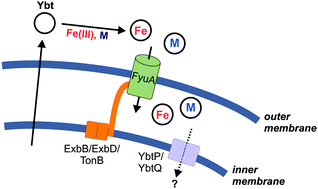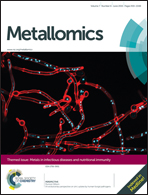Metal selectivity by the virulence-associated yersiniabactin metallophore system†
Abstract
Uropathogenic Escherichia coli secrete siderophores during human infections. Although siderophores are classically defined by their ability to bind iron(III) ions, the virulence-associated siderophore yersiniabactin was recently found to bind divalent copper ions during urinary tract infections. Here we use a mass spectrometric approach to determine the extent of non-iron(III) metal interactions by yersiniabactin and its TonB-dependent outer membrane importer FyuA. In addition to copper, iron and gallium ions, yersiniabactin was also observed to form stable nickel, cobalt, and chromium ion complexes. In E. coli, copper(II) and all other non-iron(III) yersiniabactin complexes were imported by FyuA in a TonB-dependent manner. Among metal–yersiniabactin complexes, copper(II) yersiniabactin is predicted to be structurally distinctive and was the only complex not to competitively inhibit iron(III) yersiniabactin import. These results are consistent with yersiniabactin as part of a metallophore system able to prioritize iron(III) complex uptake in high copper environments.

- This article is part of the themed collection: Metals in infectious diseases and nutritional immunity

 Please wait while we load your content...
Please wait while we load your content...